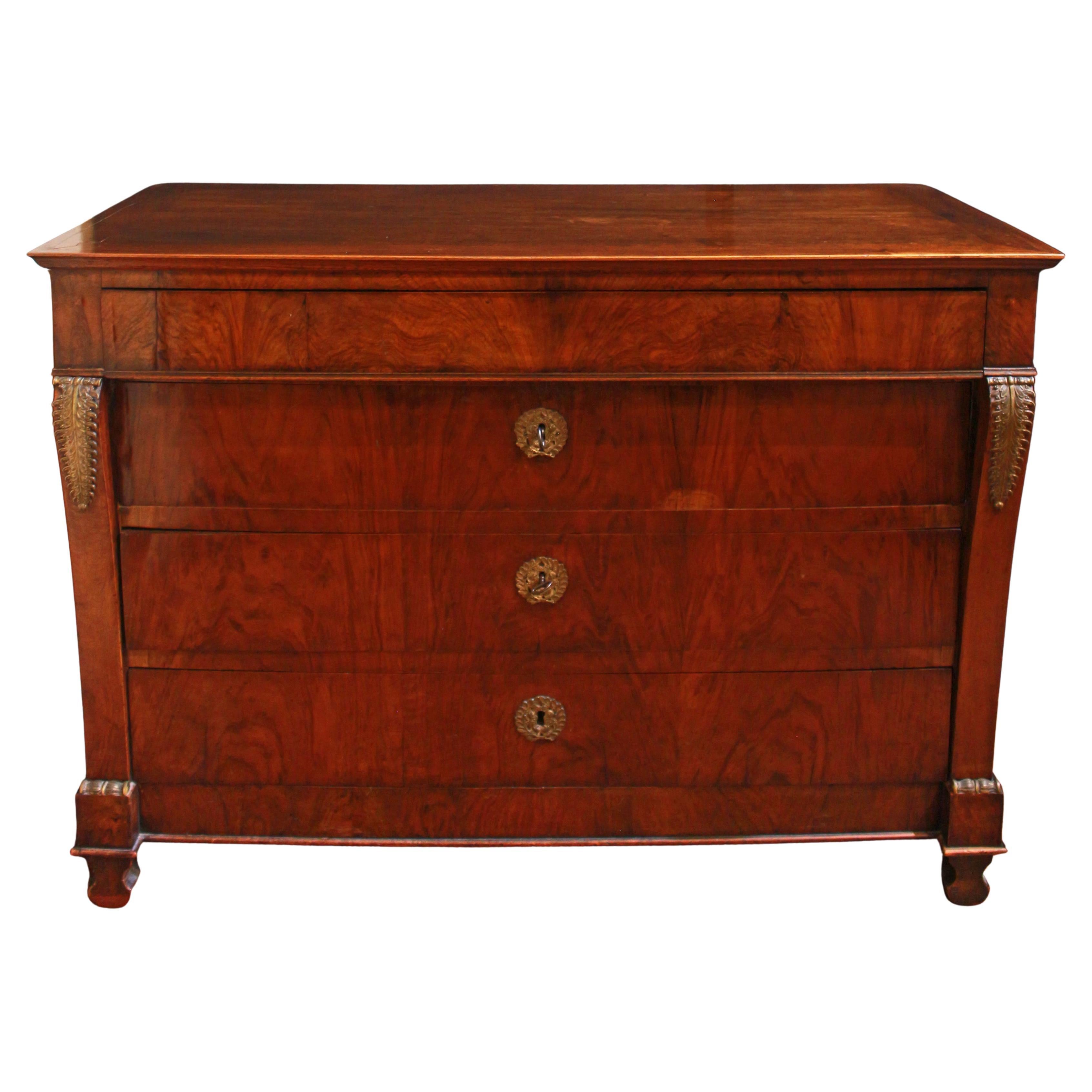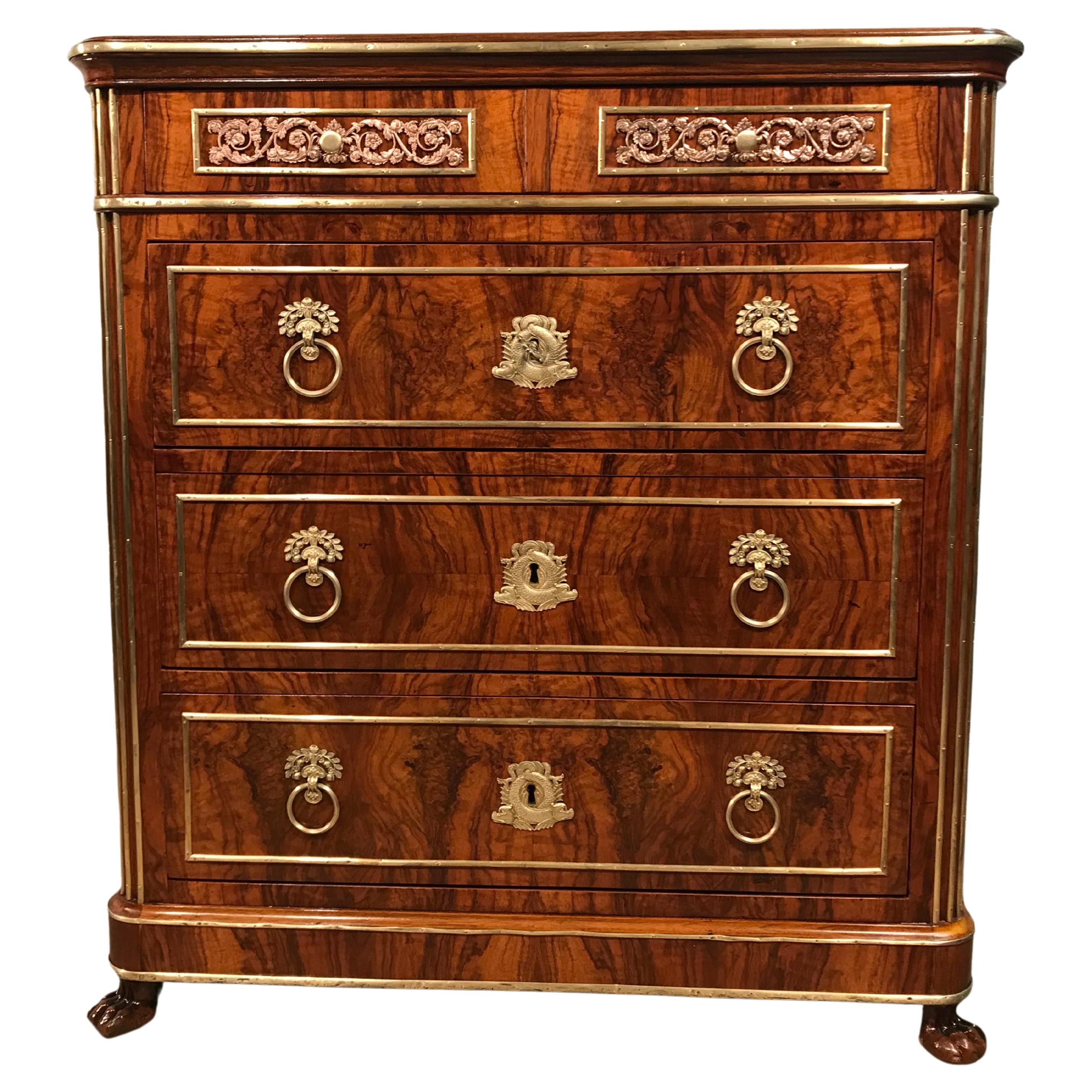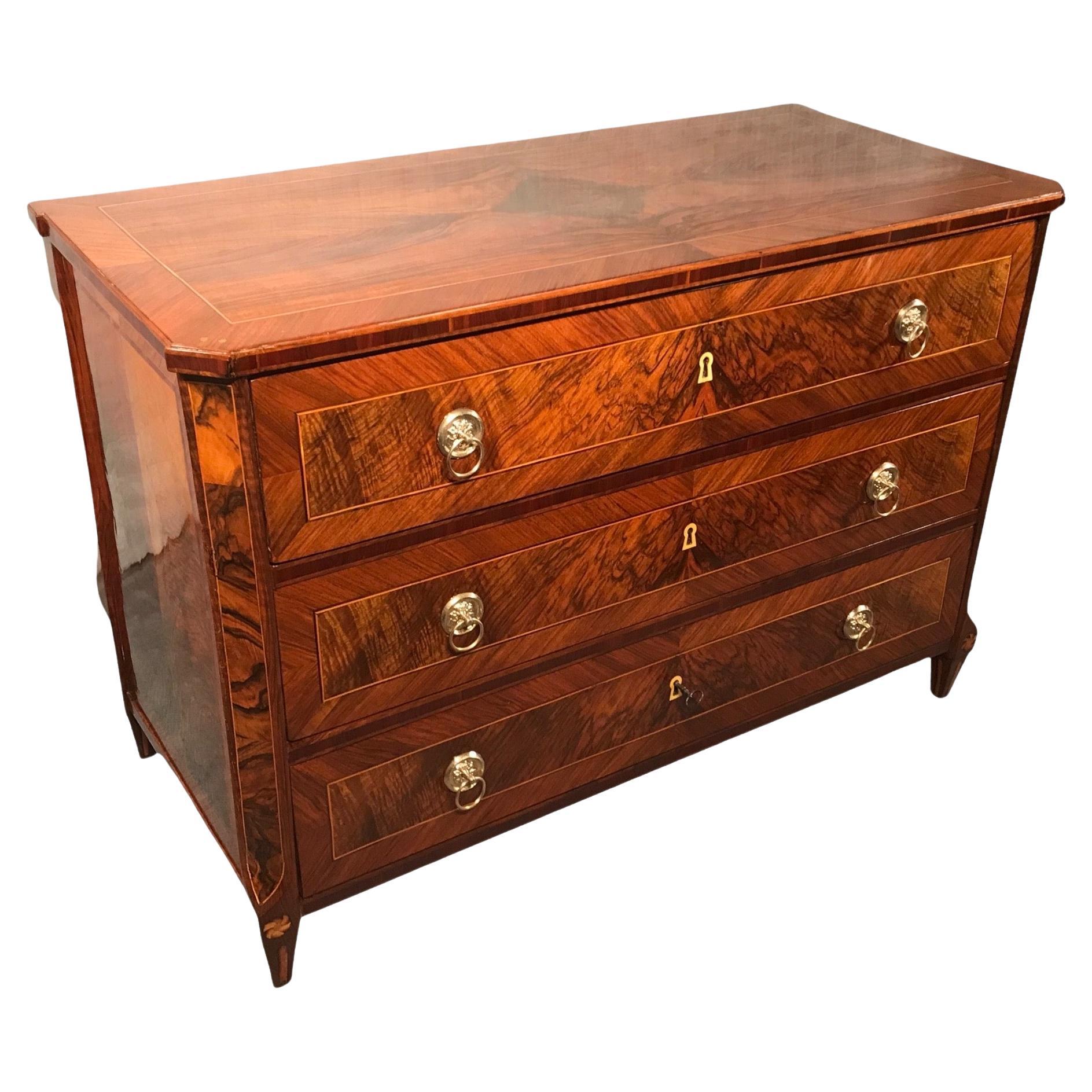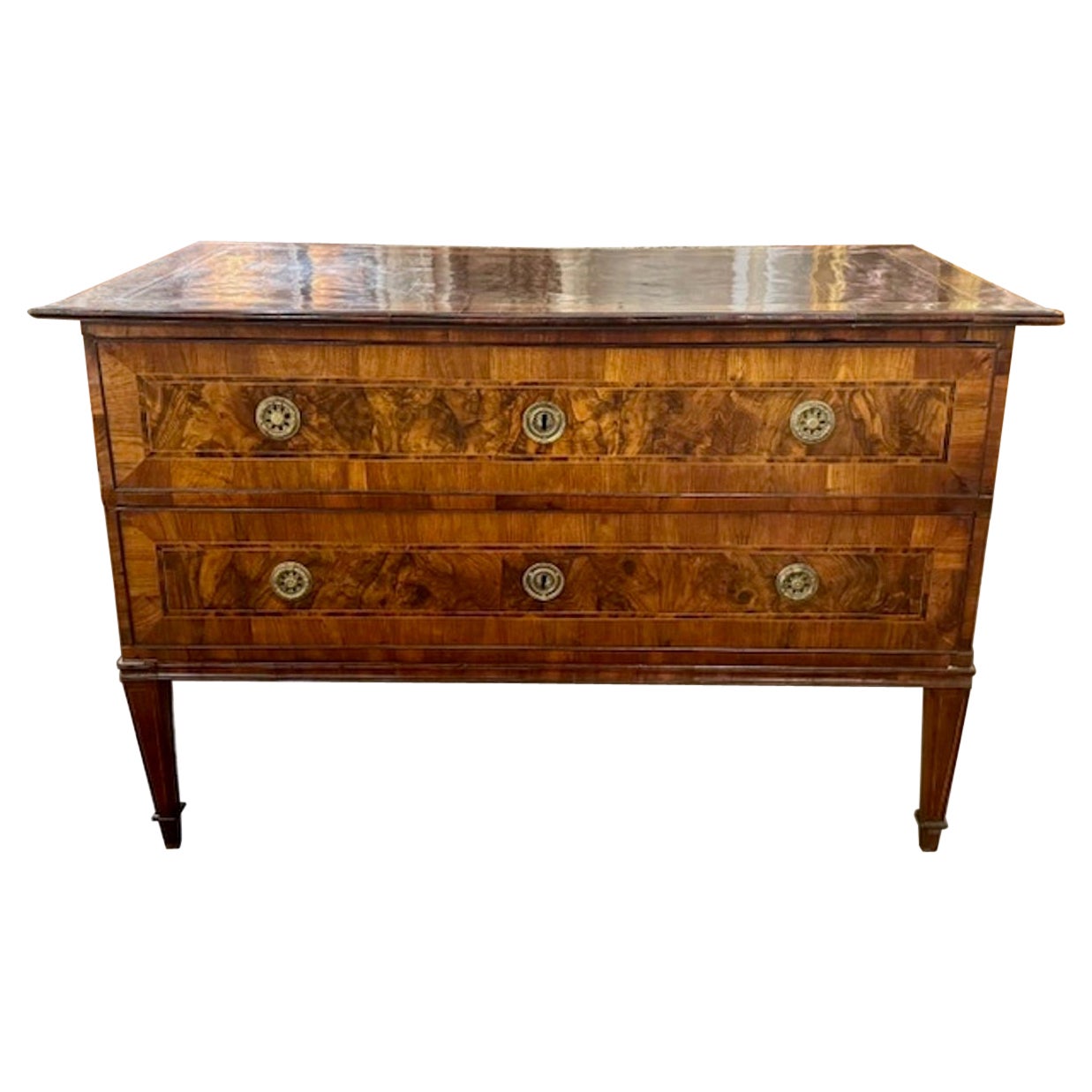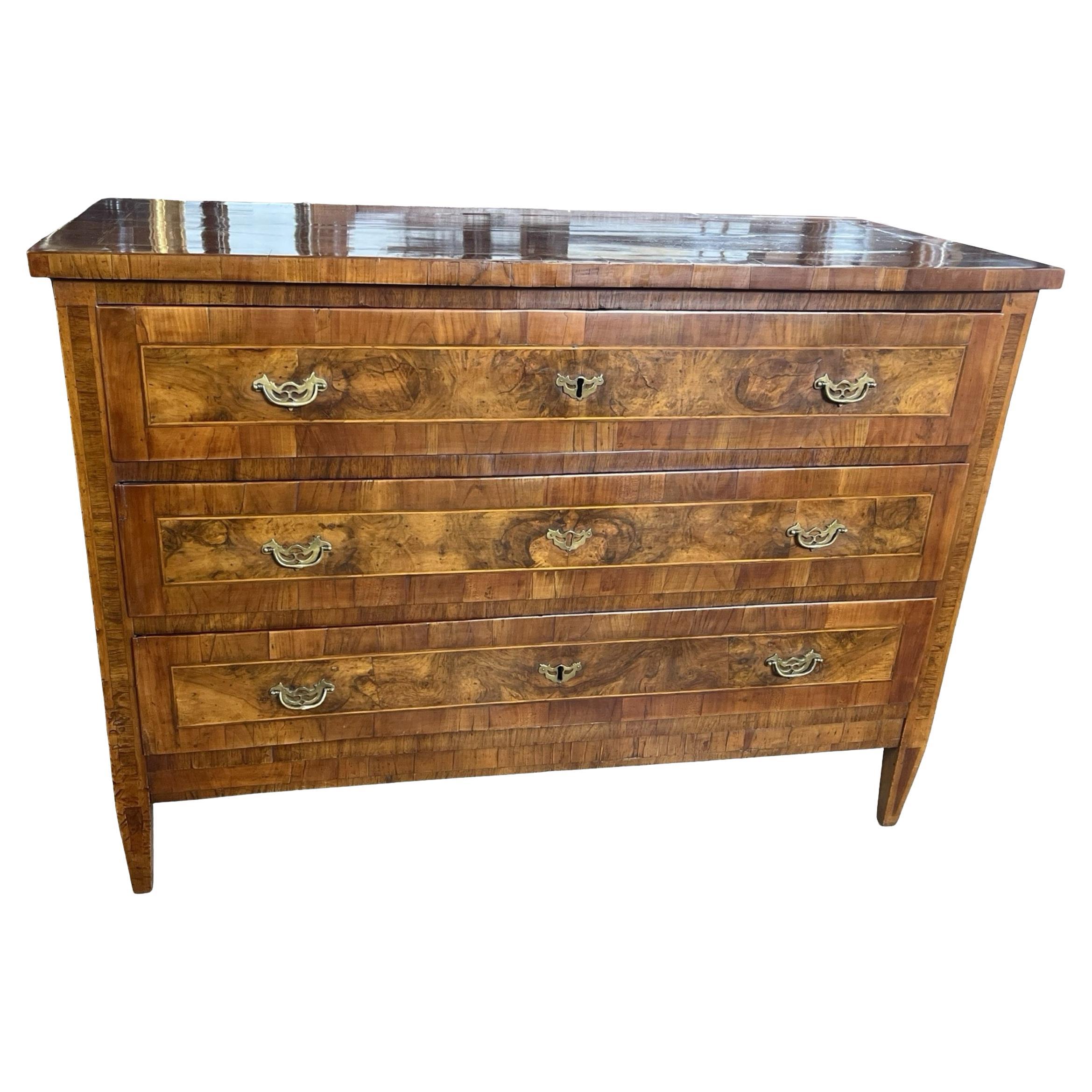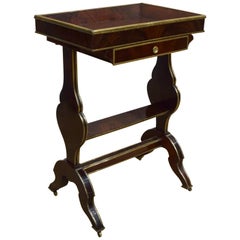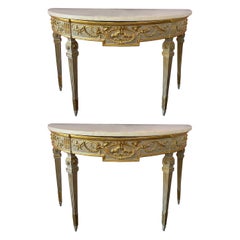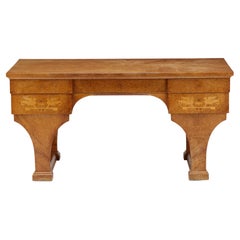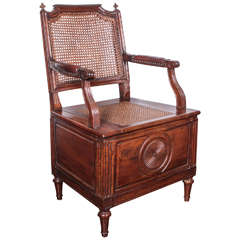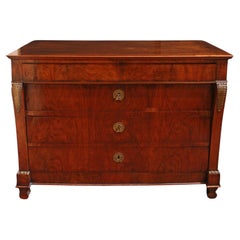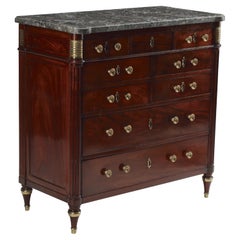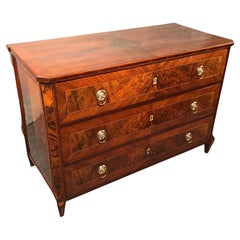Items Similar to Baltic Commode, Circa 1800
Want more images or videos?
Request additional images or videos from the seller
1 of 6
Baltic Commode, Circa 1800
$20,000
£15,405.67
€17,591.51
CA$28,534.50
A$31,226.08
CHF 16,376.65
MX$373,218
NOK 206,672.40
SEK 192,800.40
DKK 131,376
About the Item
This mahogany commode has the fluted rails and canted corners typical of case furniture made along the coasts of the Baltic and North Seas around 1800. More difficult to pinpoint, however, is the exact place of its making, since this geographical region stretches from Germany to Russia, and north from Poland to Scandinavia. That said, a strikingly similar, if slightly plainer commode in a private German collection bears an old paper label that identifies it as having been made in the city of Altona. It also bears the seal of King Christian VII of Denmark who reigned until 1808. At the time, Altona was in the independent Duchy of Schleswig-Holstein, located between Denmark and Prussia. Both nations tried to annex the Duchy, and in 1848 it was ceded to Prussia, which became part of Germany in 1871.
A North Sea port, Altona was a member of the Hanseatic League, an association of seaports that was established in the 14th century to foster trade and police the high seas. Around 1800, the aforementioned King Christian of Denmark, who was also the Duke of Schleswig-Holstein, allowed Jews to freely settle in Altona to increase the tax base. This allowed them to conduct business in neighboring Hamburg, a larger financial hub that maintained quotas. The prosperous Jewish families of Altona built villas there, and decorated them with furnishings that were made locally and imported. Many of those makers owned copies of furniture-pattern books, which were widely disseminated among these seaports, accounting for the difficulty in determining if a piece was made in Altona, Stockholm, or St. Petersburg.
We can’t trace our commode to a Danish king or a known Altona merchant, but we can link it to the New World empire builders David and Vivian Campbell. In 1945, with a $2,000 loan, they opened a record store in Montreal and expanded it to sell household electronics and appliances. They went on to establish a cable television company, and online systems for banking and brokerage houses. As philanthropists, they endowed the Art Gallery of Ontario’s Campbell Centre for Contemporary Art, and were patrons of the Toronto Symphony and the University of Toronto. They also formed an art collection, concentrating on contemporary photography, and modern painting from Edvard Munch to David Hockney. Not bad for the son of a penniless Jewish immigrant who, in 1915, set sail to Halifax from Vilnius in Poland, then under the thumb of the Czar, but an independent Hanseatic port in better days. On arrival, Samuel Kimmel didn’t speak English, and so, being incomprehensible to immigration officials, his papers were processed under the name Samuel Campbell. Decades later, on buying this commode, his son may or may not have known of its Baltic origins, or of the role of Jewish financiers in Altona.
- Dimensions:Height: 34 in (86.36 cm)Width: 37.75 in (95.89 cm)Depth: 20.25 in (51.44 cm)
- Style:Neoclassical (Of the Period)
- Materials and Techniques:
- Place of Origin:
- Period:
- Date of Manufacture:circa 1800
- Condition:Repaired: Replacement of missing drawer edging, and assorted touchups before it was polished. There were earlier repairs to veneers. Overall, in good condition, and no need for further restoration. Replacements made: One key escutchoen replaced with a perfect match. Wear consistent with age and use.
- Seller Location:New York, NY
- Reference Number:1stDibs: LU1061426085542
About the Seller
5.0
Recognized Seller
These prestigious sellers are industry leaders and represent the highest echelon for item quality and design.
Established in 1994
1stDibs seller since 2014
20 sales on 1stDibs
Typical response time: 2 hours
- ShippingRetrieving quote...Shipping from: New York, NY
- Return Policy
More From This Seller
View AllRussian 19th Century Mahogany Table
Located in New York, NY
Every contour and plane of this exquisite tray-top, mahogany table on wheels is outlined with glinting brass stringing — a hallmark of Russian cabinetry in the late 18th and early 19...
Category
Antique 1840s Russian Louis Philippe End Tables
Materials
Brass
Pair of 18th-Century Italian Console Tables
Located in New York, NY
This pair of Italian Neo-Classical console tables were carved, painted battleship-grey, gilded, and topped with slabs of Carrara marble. Each has a carved cartouche — one with a pair...
Category
Antique Late 18th Century Italian Neoclassical Credenzas
Materials
Marble
$55,000 / set
Art Deco Desk by Ernest Boiceau
By Ernest Boiceau
Located in New York, NY
This Boiceau desk bears his stamp, and was entirely veneered in amboyna, an exotic burlwood named for Ambon, the Indonesian island where it was harvested. The naturally squiggling patterning of the veneer provides an overall surface decoration. The top alone has no fewer than 60 small book-matched squares of it – ten across and six deep – creating a kaleidoscopic effect in subtle monochrome. Applied decoration is minimal. It consists of two inlaid pairs of griffins in boxwood and purplewood facing off across braziers on both the front and the back of the desk, and blind-tooled Greek keys trimming white-leather-topped shelves that slide out to either side. These decorations introduce no color, and, in lying flush with the surface, leave the sleek form undisturbed. Boiceau even eliminated drawer pulls, necessitating a lock and key for each drawer.
Born in Lausanne in 1881, Boiceau descended from French Huguenots who had settled in Switzerland. Prominent as bankers, lawyers, businessmen, and diplomats, the Boiceaus were a cosmopolitan family. Ernest studied painting in Munich, and then painting and architecture in Paris at the École des Beaux-Arts. In 1900 he embarked on a ten-year European sojourn, painting landscapes and portraits along the way. In 1910 he resettled in Paris, became interested in textiles, and established an embroidery workshop that catered to the stage and haute couture. Among his clients were the Folies Bergères, the Comédie-Française, and the Paris Opéra, and the fashion houses of Worth and Molyneux. He also made embroidered table linens, wall hangings, and upholstery fabrics. In a 1913, at an embroidery exhibition in Paris at the Musée Galliera, he presented a boudoir in collaboration with curtains, upholstery fabrics, and a tapestry, embroidered in modern abstract designs. In 1925 he launched a couture line, and branched out to design finely crafted objects and furniture made in rare woods, like ebony and Tasmanian oak...
Category
Vintage 1920s French Art Deco Desks
Materials
Bronze, Other
Louis XVI Chaise Percée
Located in New York, NY
An 18th century chaise percée, from the bathroom of Baron Max Fould-Springer, Palais Abbatial de Royaumont and by descent his sister Baroness Elie (Lilia...
Category
Antique 1780s French Louis XVI Armchairs
Materials
Mahogany
$9,000
19th-Century Neo-Classical Table
Located in New York, NY
This table’s bold, graphic, and geometrical marquetry in satinwood and rosewood recalls the paintings of Bridget Riley and other 1960s Op Art artists. The patterning even extends to...
Category
Antique 1840s Czech Neoclassical Tables
Materials
Brass
Pair of American 1940s Neo-Classical Pedestals
By McMillen
Located in New York, NY
This pair of walnut-veneered, black marble and brass neoclassical pedestals bear a striking resemblance to those that appeared in the rooms decorated in by Eleanor Brown of McMillen ...
Category
Vintage 1940s American Biedermeier Pedestals
Materials
Marble, Brass
$12,000 / set
You May Also Like
Circa 1815 French Empire 4-Drawer Commode
Located in Chapel Hill, NC
Circa 1815 French Empire 4-drawer commode. Restrained, elegant design typical of the period. Subtly shaped, flattened columns, with quality bronze mounts where they sweep out toward ...
Category
Antique 1810s French Empire Commodes and Chests of Drawers
Materials
Bronze
Neoclassical Chest of Drawers, Germany, 1800
Located in Belmont, MA
This gorgeous Neoclassical Chest of Drawers dates back to around 1800 and originates in Germany. The five drawer chest has a beautiful walnut veneer grain and stands on lions claw feet. It is decorated with its original brass fittings. The drawers are framed with brass ribbons, the upper most drawers are decorated with an exquisite brass acanthus decor. The brass escutcheons consist of two interlacing dolphins and rose vines decorate the brass handles. The unique Chest of drawers...
Category
Antique 1790s German Neoclassical Commodes and Chests of Drawers
Materials
Walnut
$5,520 Sale Price
43% Off
Neoclassical Style Mahogany Commode, 19th Century Baltic
Located in El Monte, CA
This stately Baltic chest of drawers features the hallmarks of Neoclassical design. The chest is crafted from rich mahogany and features a polished black marble top with white veinin...
Category
Antique Early 19th Century Baltic Commodes and Chests of Drawers
Materials
Marble
Neoclassical Chest of Drawers, Germany 1780
Located in Leimen, DE
This elegant Neoclassical chest of drawers comes from Germany and dates back to around 1780-1800. It stands out for its beautiful variations of walnut veneer grains. The top of the ...
Category
Antique 1780s German Neoclassical Commodes and Chests of Drawers
Materials
Walnut
$6,623 Sale Price
20% Off
Early 19th Century Italian Neo-Classical Commode
Located in Dallas, TX
The early 19th century Walnut Italian Neo-Classical Commode is a vintage piece of furniture that exudes elegance and sophistication. This commode features a beautiful inlaid pattern ...
Category
Antique Early 19th Century Neoclassical Commodes and Chests of Drawers
Materials
Walnut
18th Century Italian Neoclassical / Louis XVI Commode
Located in Carmine, TX
Neoclassical commode hand-made in Italy in the late 1700s using walnut and decorated with walnut veneer. This is an absolutely stunning chest of drawers both because of its lines and...
Category
Antique Late 18th Century Italian Neoclassical Commodes and Chests of Dr...
Materials
Walnut
More Ways To Browse
Antique German Bears
Schleswig Holstein
Antique Appliances
Danish Empire Chest Of Drawers
Swedish Gustavian Cabinet
Louis Xv Commode Marble Top
Pairs Of Three Drawers Chests
Antique English Chest Of Drawers
Marble Top Louis Xv Chest
Wood Fruit
Raised Drawers
George III Mahogany Cabinets
Pair Of Mid Century Commode
Vintage 1950 Chest Of Drawers
Antique Dressers Dressers And Chests Of Drawers
Birch Veneer
Carved Serpentine
Antique Locks And Keys
